Molecular model
A molecular model, in this article, is a physical model that represents molecules and their processes. The creation of mathematical models of molecular properties and behaviour is molecular modelling, and their graphical depiction is molecular graphics, but these topics are closely linked and each uses techniques from the others. In this article, "molecular model" will primarily refer to systems containing more than one atom and where nuclear structure is neglected. The electronic structure is often also omitted or represented in a highly sophisticated way.
Overview
Physical models of atomistic systems have played an important role in understanding chemistry and generating and testing hypotheses. Most commonly there is an explicit representation of atoms, though other approaches such as soap films and other continuous media have been useful. There are several motivations for creating physical models:
- as pedagogic tools for students or those unfamiliar with atomistic structures;
- as objects to generate or test theories (e.g., the structure of DNA);
- as analogue computers (e.g., for measuring distances and angles in flexible systems);
- as aesthetically pleasing objects on the boundary of art and science.
The construction of physical models is often a creative act, and many bespoke examples have been carefully created in the workshops of science departments. There is a very wide range of approaches to physical modelling, and this article lists only the most common or historically important. The main strategies are:
- bespoke construction of a single model;
- use of common materials (plasticine, matchsticks) or children's toys (Tinkertoy, Meccano, Lego, etc.);
- re-use of generic components in kits (ca. 1930s to present).
Models encompass a wide range of degrees of precision and engineering: some models such as J.D. Bernal's water are conceptual, while the macromodels of Pauling and Crick and Watson were created with much greater precision.
Molecular models have inspired molecular graphics, initially in textbooks and research articles and more recently on computers. Molecular graphics has replaced some functions of physical molecular models, but physical kits continue to be very popular and are sold in large numbers. Their unique strengths include:
- cheapness and portability;
- immediate tactile and visual messages;
- easy interactivity for many processes (e.g., conformational analysis and pseudorotation).
History
In the 1600s, Johannes Kepler speculated on the symmetry of snowflakes and also on the close packing of spherical objects such as fruit (this problem remained unsolved until very recently). The symmetrical arrangement of closely packed spheres informed theories of molecular structure in the late 1800s, and many theories of crystallography and solid state inorganic structure used collections of equal and unequal spheres to simulate packing and predict structure.
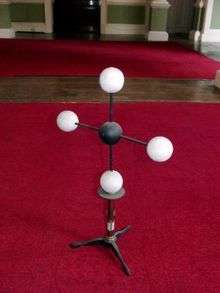
John Dalton represented compounds as aggregations of circular atoms, and although Johann Josef Loschmidt did not create physical models, his diagrams based on circles are two-dimensional analogues of later models. August Wilhelm von Hofmann is credited with the first physical molecular model around 1860 (Fig. 1). Note how the size of the carbon appears smaller than the hydrogen. The importance of stereochemistry was not then recognised and the model is essentially topological (it should be a 3-dimensional tetrahedron).
Jacobus Henricus van 't Hoff and Joseph Le Bel introduced the concept of chemistry in space—stereochemistry in three dimensions. van 't Hoff built tetrahedral molecules representing the three-dimensional properties of carbon.
Models based on spheres
Repeating units will help to show how easy it is and clear it is to represent molecules through balls that represent atoms.
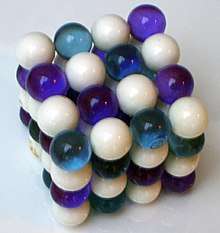
The binary compounds sodium chloride (NaCl) and caesium chloride (CsCl) have cubic structures but have different space groups. This can be rationalised in terms of close packing of spheres of different sizes. For example, NaCl can be described as close-packed chloride ions (in a face-centered cubic lattice) with sodium ions in the octahedral holes. After the development of X-ray crystallography as a tool for determining crystal structures, many laboratories built models based on spheres. With the development of plastic or polystyrene balls it is now easy to create such models.
Models based on ball-and-stick
The concept of the chemical bond as a direct link between atoms can be modelled by linking balls (atoms) with sticks/rods (bonds). This has been extremely popular and is still widely used today. Initially atoms were made of spherical wooden balls with specially drilled holes for rods. Thus carbon can be represented as a sphere with four holes at the tetrahedral angles cos−1(−1⁄3) ≈ 109.47°.
A problem with rigid bonds and holes is that systems with arbitrary angles could not be built. This can be overcome with flexible bonds, originally helical springs but now usually plastic. This also allows double and triple bonds to be approximated by multiple single bonds (Fig. 3).
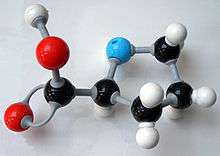
Figure 3 represents a ball-and-stick model of proline. The balls have colours: black represents carbon (C); red, oxygen (O); blue, nitrogen (N); and white, hydrogen (H). Each ball is drilled with as many holes as its conventional valence (C: 4; N: 3; O: 2; H: 1) directed towards the vertices of a tetrahedron. Single bonds are represented by (fairly) rigid grey rods. Double and triple bonds use two longer flexible bonds which restrict rotation and support conventional cis/trans stereochemistry.
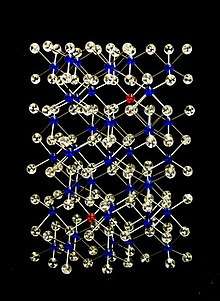
However, most molecules require holes at other angles and specialist companies manufacture kits and bespoke models. Besides tetrahedral, trigonal and octahedral holes, there were all-purpose balls with 24 holes. These models allowed rotation about the single rod bonds, which could be both an advantage (showing molecular flexibility) and a disadvantage (models are floppy). The approximate scale was 5 cm per ångström (0.5 m/nm or 500,000,000:1), but was not consistent over all elements.
Arnold Beevers in Edinburgh created small models using PMMA balls and stainless steel rods. By using individually drilled balls with precise bond angles and bond lengths in these models, large crystal structures to be accurately created, but with light and rigid form. Figure 4 shows a unit cell of ruby in this style.
Skeletal models
Crick and Watson's DNA model and the protein-building kits of Kendrew were among the first skeletal models. These were based on atomic components where the valences were represented by rods; the atoms were points at the intersections. Bonds were created by linking components with tubular connectors with locking screws.
André Dreiding introduced a molecular modelling kit in the late 1950s which dispensed with the connectors. A given atom would have solid and hollow valence spikes. The solid rods clicked into the tubes forming a bond, usually with free rotation. These were and are very widely used in organic chemistry departments and were made so accurately that interatomic measurements could be made by ruler.
More recently, inexpensive plastic models (such as Orbit) use a similar principle. A small plastic sphere has protuberances onto which plastic tubes can be fitted. The flexibility of the plastic means that distorted geometries can be made.
Polyhedral models
Many inorganic solids consist of atoms surrounded by a coordination sphere of electronegative atoms (e.g. PO4 tetrahedra, TiO6 octahedra). Structures can be modelled by gluing together polyhedra made of paper or plastic.
Composite models
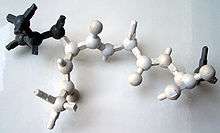
A good example of composite models is the Nicholson approach, widely used from the late 1970s for building models of biological macromolecules. The components are primarily amino acids and nucleic acids with preformed residues representing groups of atoms. Many of these atoms are directly moulded into the template, and fit together by pushing plastic stubs into small holes. The plastic grips well and makes bonds difficult to rotate, so that arbitrary torsion angles can be set and retain their value. The conformations of the backbone and side chains are determined by pre-computing the torsion angles and then adjusting the model with a protractor.
The plastic is white and can be painted to distinguish between O and N atoms. Hydrogen atoms are normally implicit and modelled by snipping off the spokes. A model of a typical protein with approximately 300 residues could take a month to build. It was common for laboratories to build a model for each protein solved. By 2005, so many protein structures were being determined that relatively few models were made.
Computer-based models

With the development of computer-based physical modelling, it is now possible to create complete single-piece models by feeding the coordinates of a surface into the computer. Figure 6 shows models of anthrax toxin, left (at a scale of approximately 20 Å/cm or 1:5,000,000) and green fluorescent protein, right (5 cm high, at a scale of about 4 Å/cm or 1:25,000,000) from 3D Molecular Design. Models are made of plaster or starch, using a rapid prototyping process.
It has also recently become possible to create accurate molecular models inside glass blocks using a technique known as subsurface laser engraving. The image at right (Fig. 7) shows the 3D structure of an E. coli protein (DNA polymerase beta-subunit, PDB code 1MMI) etched inside a block of glass by British company Luminorum Ltd.
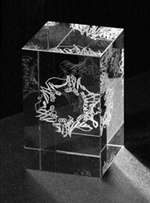
Common colors
Some of the most common colors used in molecular models are as follows:
Hydrogen white Alkali metals violet Alkaline earth metals dark green Boron, most transition metals Pink Carbon black Nitrogen blue Oxygen red Fluorine green yellow Chlorine lime green Bromine dark red Iodine dark violet Noble gases cyan Phosphorus orange Sulfur yellow Titanium gray Copper apricot Mercury light grey
Chronology
This table is an incomplete chronology of events where physical molecular models provided major scientific insights.
| Developer(s) | Date | Technology | Comments |
|---|---|---|---|
| Johannes Kepler | c. 1600 | sphere packing, symmetry of snowflakes. | |
| Johann Josef Loschmidt | 1861 | 2-D graphics | representation of atoms and bonds by touching circles |
| August Wilhelm von Hofmann | 1860 | ball-and-stick | first recognisable physical molecular model |
| Jacobus Henricus van 't Hoff | 1874 | paper? | representation of atoms as tetrahedra supported the development of stereochemistry |
| John Desmond Bernal | c. 1930 | Plasticine and spokes | model of liquid water |
| Robert Corey, Linus Pauling, Walter Koltun (CPK coloring) | 1951 | Space-filling models of alpha-helix, etc. | Pauling's "Nature of the Chemical Bond" covered all aspects of molecular structure and influenced many aspects of models |
| Francis Crick and James D. Watson | 1953 | spikes, flat templates and connectors with screws | model of DNA |
| Molecular graphics | c. 1960 | display on computer screens | complements rather than replaces physical models |
See also
- Molecular design software
- Molecular graphics
- Molecular modelling
- Ribbon diagram
- Software for molecular mechanics modeling
- Space-filling (Calotte) model
References
(Some of these have interesting and/or beautiful images)
- Barlow, W. (1883). "Probable Nature of the Internal Symmetry of Crystals". Nature. 29 (738): 186–8. Bibcode:1883Natur..29..186B. doi:10.1038/029186a0.
- Barlow, W.; Pope, W.J. (1906). "A development of the atomic theory which correlates chemical and crystalline structure and leads to a demonstration of the nature of valency". J. Chem. Soc. 89: 1675–1744. doi:10.1039/ct9068901675.
- Whittaker, A.G. (2009). "Molecular Models - Tangible Representations of the Abstract". PDB Newsletter. 41: 4–5.
- Dalton's paper on atoms and chemical compounds.
- history of molecular models Paper presented at the EuroScience Open Forum (ESOF), Stockholm on August 25, 2004 W. Gerhard Pohl, Austrian Chemical Society. Photo of van't Hoff's tetrahedral models, and Loschmidt's organic formulae (only 2-dimensional).
- Wooster, W.A.; et al. (1945). "A Spherical Template for Drilling Balls for Crystal Structure Models". J. Sci. Instrum. 22 (7): 130. Bibcode:1945JScI...22..130W. doi:10.1088/0950-7671/22/7/405. Wooster's biographical notes including setting up of Crystal Structure Ltd.
- 3D Molecular Design
- RealAtoms
- Snatoms
- xeo xeo is a free (GPL) open project management for nanostructures using Java
- History of Visualization of Biological Macromolecules by Eric Martz and Eric Francoeur. Contains a mixture of physical models and molecular graphics.
- Free to use images of molecular models made by Miramodus ltd.
- Models at Scripps Research Institute